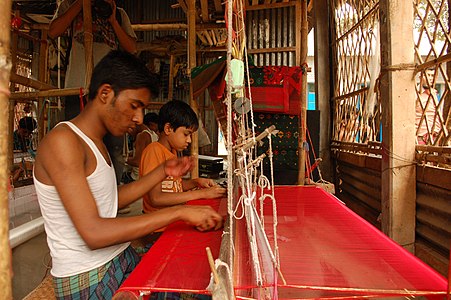
"Narrow cloth" (streit, strait,[1] narrow ware articles, narrow ware woven[2]) is cloth of a comparatively narrow width, generally less than a human armspan; precise definitions vary.
Historically, human factors and ergonomics limited the width that could practically be woven by a single weaver on a handloom. The weaver had to be able to reach both edges of the cloth, so they could throw the shuttle through the shed. A weaver thus could not weave a bolt wider than their armspan.[3] So cloth was typically made in narrow widths on narrow-width handlooms.[4][5]
Wider widths once had to be woven with a person on each side of the loom, usually the master weaver and an apprentice, throwing the shuttle back and forth between them.[6]: 29 [3] In 1733, the flying shuttle was invented. Flying shuttles made it possible for a single hand weaver to weave widths greater than their armspan, halving the labour required to make broadcloth.[7] Fabric widths became limited by the impracticality of transporting very wide bolts and looms.
Various maximum measures of breadth were used to legally define narrow cloth, and "broadcloth" was often regulated to be twice the width of narrow cloth (). The word "broadcloth" was originally used just as an antonym to "narrow cloth", but later came to mean a particular type of cloth (see broadcloth).[1] The 1909 Webster's dictionary (as reprinted in 1913) defines broadcloth as "A fine smooth-faced woolen cloth for men's garments, usually of double width".[8] thus giving both the old breadth-based distinction and the newer definition based on the type of cloth. Broadwoven and narrow woven are unambiguous terms, used by the US government.[9]
-
-
A weaver passes the shuttle through the shed of her treadle loom.
-
Weaving jamdani on a two-person loom.
-
An early fully-automated loom. The arms at the sides can be seen swinging to bash the flying shuttle back and forth.
- ^ a b Cite error: The named reference
enbritwas invoked but never defined (see the help page). - ^ Appeals, United States Court of Customs and Patent (1971). Cases Decided in United States Court of Customs and Patent Appeals: Customs Cases Adjudged in the Court of Customs and Patent Appeals. The Court. p. 121.
- ^ a b "About the size of tanmono (a roll of kimono cloth)". hirotatsumugi.jp. Hirota Tsumugi. Archived from the original on 4 July 2020. Retrieved 27 January 2020.
- ^ Courts, Witney (England) Borough (1985). Oxfordshire Record Society. Produced for the Society by A. Sutton. pp. LXXCV, XCV. ISBN 978-0-902509-18-4.
- ^ Cite error: The named reference
:0was invoked but never defined (see the help page). - ^ Bodey, Hugh (1976). Textiles. Internet Archive. London : B. T. Batsford. ISBN 978-0-7134-3052-3.
- ^ "History of technology". www.historyworld.net. Retrieved 2 November 2017.
- ^ "Webster's 1913". www.websters1913.com.,
- ^ Cite error: The named reference
broadwovenwas invoked but never defined (see the help page).

